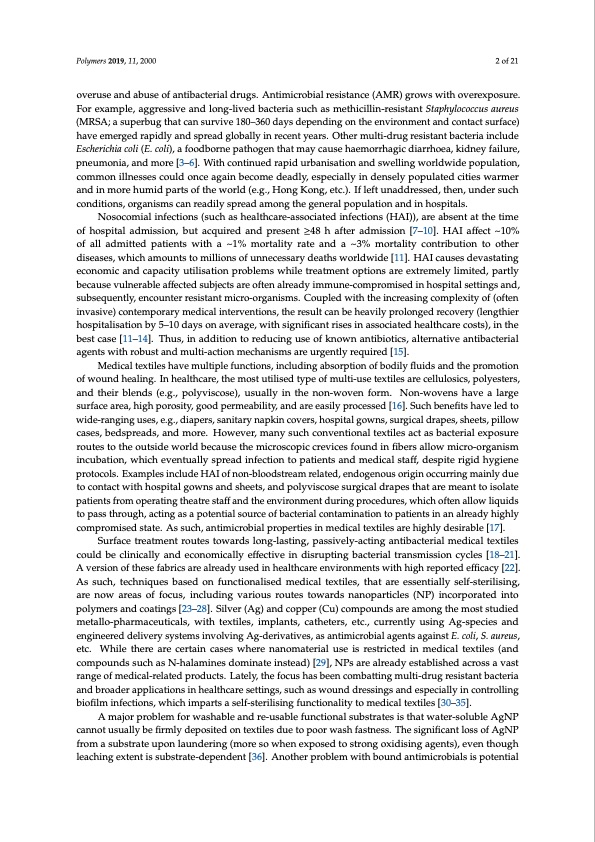
PDF Publication Title:
Text from PDF Page: 002
Polymers 2019, 11, 2000 2 of 21 overuse and abuse of antibacterial drugs. Antimicrobial resistance (AMR) grows with overexposure. For example, aggressive and long-lived bacteria such as methicillin-resistant Staphylococcus aureus (MRSA; a superbug that can survive 180–360 days depending on the environment and contact surface) have emerged rapidly and spread globally in recent years. Other multi-drug resistant bacteria include Escherichia coli (E. coli), a foodborne pathogen that may cause haemorrhagic diarrhoea, kidney failure, pneumonia, and more [3–6]. With continued rapid urbanisation and swelling worldwide population, common illnesses could once again become deadly, especially in densely populated cities warmer and in more humid parts of the world (e.g., Hong Kong, etc.). If left unaddressed, then, under such conditions, organisms can readily spread among the general population and in hospitals. Nosocomial infections (such as healthcare-associated infections (HAI)), are absent at the time of hospital admission, but acquired and present ≥48 h after admission [7–10]. HAI affect ~10% of all admitted patients with a ~1% mortality rate and a ~3% mortality contribution to other diseases, which amounts to millions of unnecessary deaths worldwide [11]. HAI causes devastating economic and capacity utilisation problems while treatment options are extremely limited, partly because vulnerable affected subjects are often already immune-compromised in hospital settings and, subsequently, encounter resistant micro-organisms. Coupled with the increasing complexity of (often invasive) contemporary medical interventions, the result can be heavily prolonged recovery (lengthier hospitalisation by 5–10 days on average, with significant rises in associated healthcare costs), in the best case [11–14]. Thus, in addition to reducing use of known antibiotics, alternative antibacterial agents with robust and multi-action mechanisms are urgently required [15]. Medical textiles have multiple functions, including absorption of bodily fluids and the promotion of wound healing. In healthcare, the most utilised type of multi-use textiles are cellulosics, polyesters, and their blends (e.g., polyviscose), usually in the non-woven form. Non-wovens have a large surface area, high porosity, good permeability, and are easily processed [16]. Such benefits have led to wide-ranging uses, e.g., diapers, sanitary napkin covers, hospital gowns, surgical drapes, sheets, pillow cases, bedspreads, and more. However, many such conventional textiles act as bacterial exposure routes to the outside world because the microscopic crevices found in fibers allow micro-organism incubation, which eventually spread infection to patients and medical staff, despite rigid hygiene protocols. Examples include HAI of non-bloodstream related, endogenous origin occurring mainly due to contact with hospital gowns and sheets, and polyviscose surgical drapes that are meant to isolate patients from operating theatre staff and the environment during procedures, which often allow liquids to pass through, acting as a potential source of bacterial contamination to patients in an already highly compromised state. As such, antimicrobial properties in medical textiles are highly desirable [17]. Surface treatment routes towards long-lasting, passively-acting antibacterial medical textiles could be clinically and economically effective in disrupting bacterial transmission cycles [18–21]. A version of these fabrics are already used in healthcare environments with high reported efficacy [22]. As such, techniques based on functionalised medical textiles, that are essentially self-sterilising, are now areas of focus, including various routes towards nanoparticles (NP) incorporated into polymers and coatings [23–28]. Silver (Ag) and copper (Cu) compounds are among the most studied metallo-pharmaceuticals, with textiles, implants, catheters, etc., currently using Ag-species and engineered delivery systems involving Ag-derivatives, as antimicrobial agents against E. coli, S. aureus, etc. While there are certain cases where nanomaterial use is restricted in medical textiles (and compounds such as N-halamines dominate instead) [29], NPs are already established across a vast range of medical-related products. Lately, the focus has been combatting multi-drug resistant bacteria and broader applications in healthcare settings, such as wound dressings and especially in controlling biofilm infections, which imparts a self-sterilising functionality to medical textiles [30–35]. A major problem for washable and re-usable functional substrates is that water-soluble AgNP cannot usually be firmly deposited on textiles due to poor wash fastness. The significant loss of AgNP from a substrate upon laundering (more so when exposed to strong oxidising agents), even though leaching extent is substrate-dependent [36]. Another problem with bound antimicrobials is potentialPDF Image | Antimicrobial from Silver-Graphene Coated Medical Textiles

PDF Search Title:
Antimicrobial from Silver-Graphene Coated Medical TextilesOriginal File Name Searched:
polymers-11-02000-v2.pdfDIY PDF Search: Google It | Yahoo | Bing
Turbine and System Plans CAD CAM: Special for this month, any plans are $10,000 for complete Cad/Cam blueprints. License is for one build. Try before you buy a production license. More Info
Waste Heat Power Technology: Organic Rankine Cycle uses waste heat to make electricity, shaft horsepower and cooling. More Info
All Turbine and System Products: Infinity Turbine ORD systems, turbine generator sets, build plans and more to use your waste heat from 30C to 100C. More Info
CO2 Phase Change Demonstrator: CO2 goes supercritical at 30 C. This is a experimental platform which you can use to demonstrate phase change with low heat. Includes integration area for small CO2 turbine, static generator, and more. This can also be used for a GTL Gas to Liquids experimental platform. More Info
Introducing the Infinity Turbine Products Infinity Turbine develops and builds systems for making power from waste heat. It also is working on innovative strategies for storing, making, and deploying energy. More Info
Need Strategy? Use our Consulting and analyst services Infinity Turbine LLC is pleased to announce its consulting and analyst services. We have worked in the renewable energy industry as a researcher, developing sales and markets, along with may inventions and innovations. More Info
Made in USA with Global Energy Millennial Web Engine These pages were made with the Global Energy Web PDF Engine using Filemaker (Claris) software.
Infinity Turbine Developing Spinning Disc Reactor SDR or Spinning Disc Reactors reduce processing time for liquid production of Silver Nanoparticles.
| CONTACT TEL: 608-238-6001 Email: greg@infinityturbine.com | RSS | AMP |